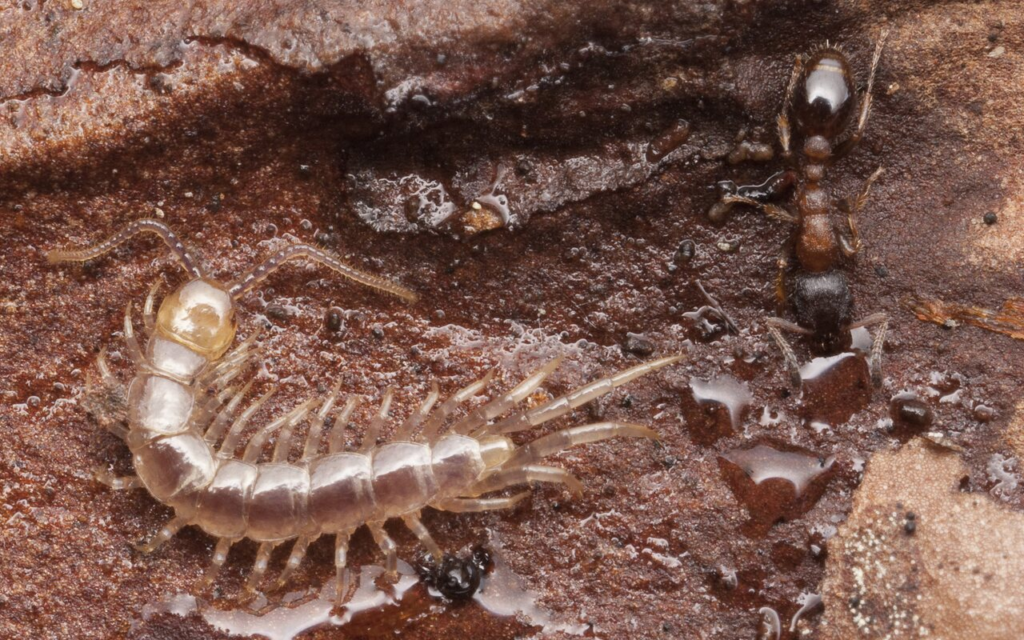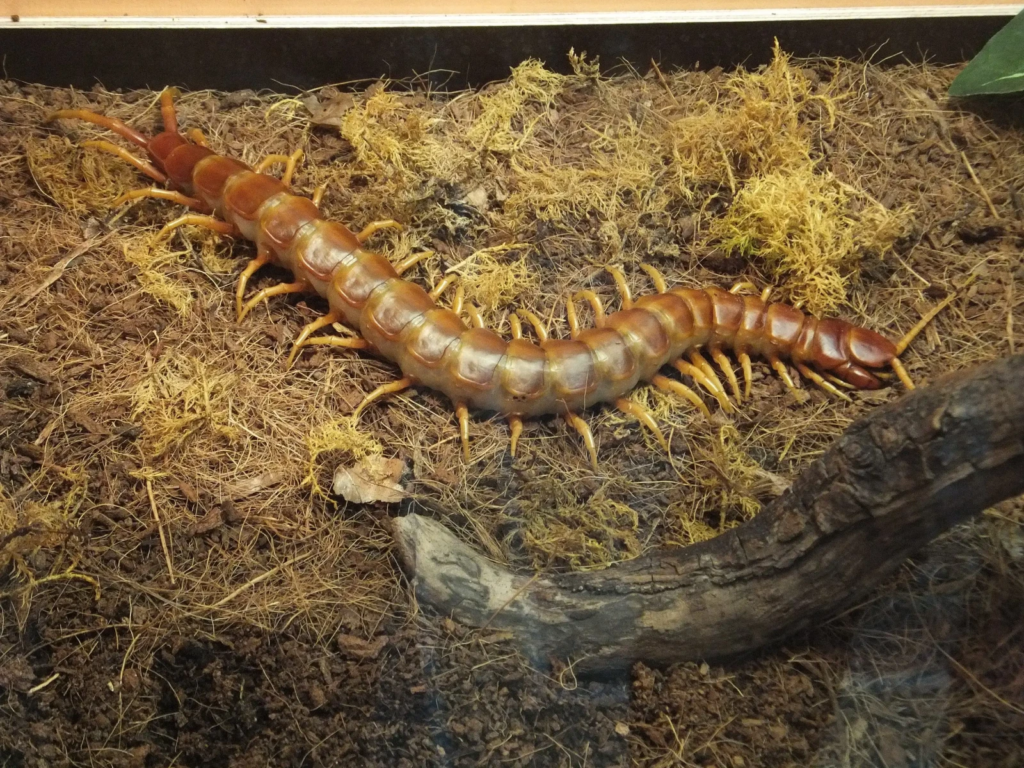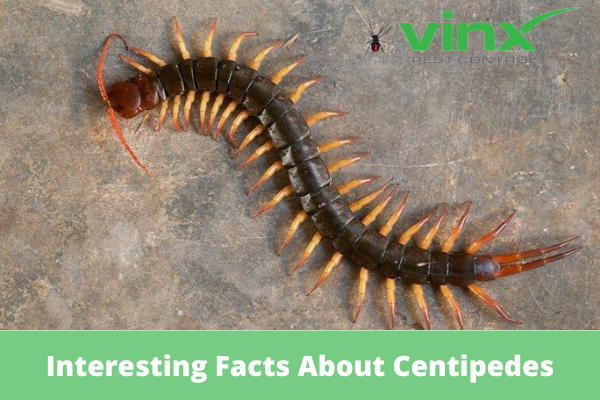Centipedes are often misunderstood creatures that belong to the arthropod family. Despite their fearsome appearance, they play a crucial role in the ecosystem by controlling pest populations.
These creepy crawlers are fascinating for their unique characteristics and behaviors. As a pest control service, Vinx Pest Control aims to educate the public about the importance and intriguing nature of these arthropods.
Key Takeaways
- Centipedes are beneficial for pest control.
- They belong to the arthropod family.
- Centipede facts reveal their unique characteristics.
- These creatures are often misunderstood.
- Vinx Pest Control provides insights into their importance.
The Fascinating World of Centipedes
For over 400 million years, centipedes have been thriving on our planet, playing a crucial role in ecosystems. These arthropods are not only fascinating due to their appearance but also because of their evolutionary history and the vital functions they perform.
What Are Centipedes?
Centipedes belong to the class Chilopoda and are characterized by their elongated, segmented bodies and numerous legs. They are predators that feed on insects and other small arthropods, thus playing a significant role in controlling pest populations.
With over 8,000 known species, centipedes vary greatly in size, shape, and behavior, adapting to various environments worldwide.

Evolutionary History of These Ancient Arthropods
The evolutionary history of centipedes dates back to the Silurian period, over 400 million years ago. Fossil records indicate that ancient centipedes were among the first arthropods to inhabit land.
Over time, they have evolved into diverse species, adapting to different habitats and developing unique characteristics. Their long history and adaptability have made centipedes successful and widespread insect predators.
Anatomy and Physical Characteristics of Centipedes
With their distinctive body structure and venomous appendages, centipedes are well-adapted predators. Centipedes belong to the class Chilopoda and are characterized by their elongated, segmented bodies.
Body Structure and Segmentation
The body of a centipede is divided into segments, each bearing one pair of legs. This segmentation allows for flexibility and enhances their centipede movement. The number of segments varies among species, contributing to the diversity within the centipede family.
Legs and Movement Capabilities
Centipedes are known for their numerous legs, which facilitate their rapid centipede movement. The structure and coordination of these legs enable centipedes to navigate various environments efficiently. Their legs are adapted for speed, allowing them to catch prey effectively.
Venom Glands and Forcipules
One of the most distinctive features of centipedes is their modified front legs, known as forcipules, which are used to deliver venom to their prey. These venomous insects utilize their forcipules to immobilize their victims, making them formidable predators in their ecosystems.
The unique centipede anatomy, including their segmented bodies and venom glands, underscores their evolutionary success as predators. Understanding these physical characteristics is essential for appreciating the biology and behavior of centipedes.

How to Identify Different Types of Centipedes
The world of centipedes is vast, comprising various species that differ significantly in appearance and behavior. Understanding these differences is crucial for accurate identification and appreciation of these arthropods.
House Centipedes (Scutigera coleoptrata)
House centipedes are one of the most commonly encountered species, particularly in indoor environments. They are characterized by their long, slender bodies and numerous legs, which enable them to move rapidly. House centipedes are typically grayish-yellow with darker stripes and can be found in damp areas such as basements and bathrooms.
Soil Centipedes (Geophilomorpha)
Soil centipedes, belonging to the order Geophilomorpha, are adapted to living in soil and under debris. They have elongated, flattened bodies that allow them to navigate through tight soil spaces. These centipedes are often found in moist, humid environments and play a crucial role in soil ecosystems.
Stone Centipedes (Lithobiomorpha)
Stone centipedes are another common type, often found under rocks and stones. They have a more compact body compared to house centipedes and are generally faster movers. Stone centipedes are predators that feed on small insects and are beneficial to garden ecosystems.
Giant Desert Centipedes (Scolopendra heros)
The giant desert centipede is one of the larger species, known for its impressive size and venomous forcipules. Found in arid regions, these centipedes are adapted to dry environments and are capable of delivering painful bites. They are nocturnal hunters, preying on insects and small animals.
Identifying the different types of centipedes requires an understanding of their physical characteristics, habitats, and behaviors. By recognizing these differences, individuals can better appreciate the diversity within the centipede family and manage their presence effectively.

Common Centipede Habitats and Distribution
Centipedes inhabit diverse ecosystems, from outdoor landscapes to indoor settings. Their ability to adapt to various environments contributes to their widespread distribution.
Outdoor Environments Where Centipedes Thrive
Outdoors, centipedes are commonly found in moist, humid areas such as under leaf litter, in soil, and beneath rocks or logs. These environments provide them with shelter, moisture, and prey.
Soil centipedes, for example, are well adapted to living in soil and underground areas, where they feed on small invertebrates.
Indoor Conditions That Attract Centipedes
Indoors, centipedes are attracted to damp, humid conditions often found in bathrooms, basements, and crawl spaces. They seek out areas with high moisture levels, such as near leaky pipes or in damp corners.
House centipedes, in particular, are common indoor dwellers, feeding on other small arthropods that they encounter in these environments.
Centipede Diet and Predatory Behavior
Understanding what centipedes eat and how they hunt is essential for appreciating their ecological role. Centipedes are carnivorous arthropods that feed on a variety of prey, playing a significant part in controlling insect and invertebrate populations.
What Do Centipedes Eat?
Centipedes are predators that consume a wide range of insects, worms, and other small invertebrates. Their diet typically includes flies, spiders, and other arthropods they encounter in their habitat. The specific prey can vary depending on the centipede species and its environment.

Hunting Techniques and Prey Capture
Centipedes use their speed, venom, and modified front legs (forcipules) to capture and subdue their prey. They are active hunters, often moving quickly to catch their victims off guard. The venom delivered through their forcipules is crucial for immobilizing prey, allowing centipedes to effectively feed on a variety of invertebrates.
The Reproduction and Life Cycle of Centipedes
Understanding the life cycle of centipedes requires a look into their mating habits and growth patterns. Centipedes exhibit unique reproductive behaviors that are crucial for their survival.
Mating Rituals and Reproductive Strategies
Centipedes have intriguing mating rituals. Males typically deposit a spermatophore, which the female then takes up. This process varies among species, with some males performing complex courtship behaviors to ensure successful mating. The reproductive strategies of centipedes are adapted to their environment, enhancing their chances of survival.
Development Stages and Typical Lifespan
After mating, female centipedes lay eggs in a protected location. The eggs hatch into larvae, which then go through several molts as they grow. The number of legs and body segments increase with each molt until they reach maturity. The lifespan of centipedes varies by species, with some living up to 5-6 years in optimal conditions. Factors such as food availability, humidity, and temperature significantly influence their lifespan.
Ecological Importance of Centipedes
The ecological importance of centipedes cannot be overstated, as they contribute significantly to pest control. By preying on various insects and arthropods, centipedes help maintain the balance of ecosystems.
Benefits in Gardens
Centipedes are particularly beneficial in gardens, where they act as natural pest control agents. They feed on pests that can damage plants, such as aphids, flies, and spiders, thereby reducing the need for pesticides and maintaining soil health.
Role in Ecosystem
In addition to their role in gardens, centipedes play a crucial part in ecosystem balance. They are both predators and prey, contributing to the food chain and helping to regulate the populations of other animals. This balance is essential for the health and diversity of ecosystems.
Recognizing a Centipede Infestation in Your Home
Recognizing the signs of a centipede infestation is crucial for effective pest management. Centipedes, though generally harmless, can be a nuisance when they invade homes. Understanding the indicators of their presence can help homeowners take timely action.
Common Signs of Centipede Presence
One of the most obvious signs of a centipede infestation is sighting these arthropods, especially at night when they are most active. Homeowners might notice them in damp areas, such as basements or bathrooms, where moisture is prevalent. Centipedes are also attracted to decaying organic matter, so their presence can indicate underlying issues like dampness or poor ventilation.
Another sign is the presence of centipede eggs or young centipedes. Female centipedes lay their eggs in protected areas, and the young ones can be seen scurrying around as they mature. While centipedes are not typically aggressive towards humans, their presence can be unsettling.

Areas of Your Home Most Vulnerable to Centipedes
Centipedes prefer damp, humid environments, making certain areas of the home more susceptible to infestations. Basements, crawl spaces, and bathrooms are common places to find centipedes due to their typically higher moisture levels. Clogged drains, leaky pipes, and poor ventilation can contribute to the damp conditions that centipedes favor.
Seasonal Patterns in Centipede Activity
Centipede activity can vary with the seasons. In warmer months, centipedes are more active and may venture into homes seeking prey. During colder months, they may seek shelter indoors, leading to increased sightings. Understanding these seasonal patterns can help homeowners anticipate and prepare for potential centipede infestations.
By being aware of the signs of centipede presence, vulnerable areas in the home, and seasonal patterns in their activity, homeowners can better manage centipede infestations and maintain a more comfortable living environment.
Health Concerns Related to Centipedes
While centipedes are generally harmless, their bites can cause significant discomfort and health concerns. Centipede bites are relatively rare and usually occur when these arthropods are provoked or threatened. Understanding the implications of a centipede bite is essential for proper management and treatment.
Centipede Bites: Symptoms and First Aid
Centipede bites can result in pain, swelling, and redness at the bite site. Some individuals may experience more severe reactions, including blistering or an allergic response. First aid for centipede bites typically involves cleaning the wound with soap and water, applying a cold compress to reduce swelling, and using over-the-counter pain relievers to manage discomfort.
When to Seek Medical Attention After a Bite
Most centipede bites do not require medical attention and resolve on their own within a few days. However, if symptoms persist, worsen, or if signs of infection appear (such as increased redness, swelling, or pus), it is advisable to seek medical care. Severe allergic reactions to centipede bites are rare but necessitate immediate medical intervention.
Distinguishing Centipede Bites from Other Insect Bites
Centipede bites can be mistaken for bites from other insects, such as spiders or ants. A key distinguishing feature is the presence of two puncture wounds from the centipede’s forcipules. Understanding the characteristics of centipede bites can help in identifying and managing the bite appropriately.
Professional Methods to Get Rid of Centipedes
To effectively get rid of centipedes, it’s essential to understand the professional methods available. Centipede infestations can be challenging to manage, but with the right strategies, homeowners can eliminate these pests.
Integrated Pest Management Approaches
Integrated Pest Management (IPM) is a holistic approach that involves combining physical, cultural, biological, and chemical controls to manage pest populations. For centipedes, IPM includes sealing entry points, reducing moisture, and eliminating food sources. By adopting IPM strategies, homeowners can create an environment that is less conducive to centipede infestations.
Sealing cracks and crevices around windows, doors, and pipes can help prevent centipedes from entering homes. Additionally, reducing humidity through the use of dehumidifiers and improving ventilation can make the environment less appealing to these pests.
Chemical Treatment Options
Chemical treatments can be an effective way to control centipede infestations. Insecticides containing pyrethroids or organophosphates can be used to kill centipedes. However, it’s crucial to follow the product instructions and take necessary precautions to avoid exposure.
For severe infestations, professional pest control services may recommend baits or sprays that are specifically designed to target centipedes. These treatments can be applied in areas where centipedes are most active.

When to Call Professional Pest Control Services
If the infestation is severe or persistent, it may be necessary to call professional pest control services. These professionals have the training and equipment to effectively manage centipede populations. They can identify the source of the infestation and provide targeted treatments to eliminate the pests.
Professional pest control services can also offer guidance on how to prevent future infestations, providing homeowners with the knowledge they need to keep their homes centipede-free.
Get Rid of Centipedes: DIY Strategies
Centipede infestations can be managed with the right DIY approach, using home remedies and natural repellents. Homeowners can take several steps to control and eliminate centipedes without relying on professional services.
Effective Home Remedies for Centipede Removal
Several home remedies can help in getting rid of centipedes. One effective method is to reduce humidity levels in your home, as centipedes thrive in moist environments. Using a dehumidifier, especially in basements or crawl spaces, can make your home less appealing to these pests.
Another home remedy involves using sticky traps. Placing sticky traps in areas where centipedes are commonly seen can help capture and remove them. Additionally, sealing any cracks or crevices around your home can prevent further infestations.
Natural Centipede Repellents That Actually Work
Certain natural substances can repel centipedes. For instance, the smell of citrus can deter centipedes. Placing citrus peels or spraying citrus-based cleaners in areas where centipedes are present can help repel them.
Essential oils like tea tree oil and lavender oil also have natural repellent properties. Mixing a few drops of these oils with water and spraying the solution around the home can help keep centipedes away.
Safe Capture and Removal Techniques
When it comes to removing centipedes, it’s essential to do so safely. Wearing gloves can protect you from potential bites. Using a container or a jar to capture centipedes is a safe method for removal. Once captured, centipedes can be released outside, far away from your home.
It’s also crucial to identify and address the underlying causes of the infestation, such as moisture issues or food sources, to prevent future occurrences.
Preventing Future Centipede Infestations
Maintaining a centipede-free home involves a combination of good housekeeping, moisture control, and sealing entry points. By understanding and addressing the factors that attract centipedes to your home, you can significantly reduce the likelihood of an infestation.
Home Maintenance to Deter Centipedes
Regular home maintenance is crucial in deterring centipedes. This includes keeping your home clean and clutter-free, as centipedes are attracted to hiding in cluttered areas. Regularly vacuuming and dusting, especially in areas prone to moisture like basements and bathrooms, can help remove centipede eggs and larvae. Additionally, decluttering storage areas and keeping boxes off the floor can reduce hiding spots for centipedes.
Moisture Control and Dehumidification
Centipedes thrive in humid environments. Therefore, controlling moisture levels in your home is essential. Using dehumidifiers, especially in damp areas like basements and crawl spaces, can make your home less appealing to centipedes. Fixing any water leaks and ensuring proper drainage around your home’s foundation also helps in reducing moisture that might attract centipedes.
Sealing Entry Points and Creating Barriers
Sealing all entry points around your home is a critical step in preventing centipede infestations. This includes caulking cracks and crevices around windows, doors, and pipes. Installing door sweeps and weatherstripping around doors can also help seal gaps that centipedes might use to enter your home. By creating these barriers, you can significantly reduce the chance of centipedes entering your living spaces.
Conclusion: Understanding and Managing Centipedes
Understanding centipedes is crucial for effective pest control and management. By grasping their biology and behavior, homeowners can better manage infestations and prevent future occurrences. Centipede management involves a comprehensive approach, including identifying the different types of centipedes, recognizing the signs of infestation, and implementing DIY strategies or professional methods to get rid of them.
Effective centipede management also requires understanding their habitats, diet, and reproduction patterns. By controlling moisture levels, sealing entry points, and maintaining a clean home environment, individuals can deter centipedes from inhabiting their homes. Moreover, being aware of the ecological importance of centipedes can help in adopting a balanced approach to pest control.
Centipedes are fascinating creatures despite their terrible reputation. They are, of course, one of those animals that seem the coolest from a distance. Call us now if you’ve seen any centipedes invading your home, and we’ll immediately take care of the problem. Vinx Pest Control will be at your service!



